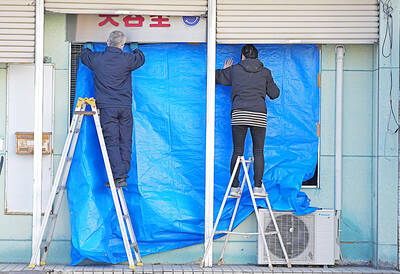Completion of upgrades to four boiler units at the coal-fired Taichung Power Plant earlier this year would reduce its air pollutant emissions by 80 percent over the next five years, Premier Su Tseng-chang (蘇貞昌) told a weekly Cabinet meeting on Thursday.
Su told the meeting that the plant’s emissions last year had decreased by half from 2016 levels, Executive Yuan spokesman Ting Yi-ming (丁怡銘) quoted Su as saying, adding that the Executive Yuan in May last year agreed to budget NT$15 billion (US$508.37 million at the current exchange rate) to fund the upgrading of the plant’s boiler units No. 5 to No. 10.
The government is responsible for improving air quality by reducing air pollution, Su said.
Environmental advocates have repeatedly complained about pollution by the Taichung power plant and called for the reduction of the use of coal.
About 40 percent of Taiwan’s air pollution originates outside of the nation’s borders and is difficult to control, but through interdepartmental collaboration and increased dialogue between the central and local governments, it is possible to implement policies targeting the three main sources of controllable air pollution, Su said.
These collaborations have produced significant results, with red alerts for fine particulate matter smaller than 2.5 micrometers (PM2.5) improving by 85 percent from 997 times in 2015 to 146 times last year, Su said.
Southern Taiwan, which is usually more affected by PM2.5 pollution during autumn, saw zero red alerts last year, compared with 120 times in 2018, while the Yunlin-Chiayi-Tainan area saw red alerts drop from 99 to 9 times last year, he said.
Citing statistics from Kaohsiung’s Siaogang District (小港), Su said that sulfur dioxide emissions dropped by half from 2017 levels.
Dust levels over the Jhuoshuei River (濁水溪) were also halved compared with 2018 levels, he said.
Efforts by the Ministry of Economic Affairs and the Ministry of Transportation and Communications to encourage the public to exchange aging two-cycle engine scooters resulted in 910,000, or 60 percent, of vehicles being exchanged, Su said.
More than 3,700 low-pollution boiler units used for industrial or commercial purposes have been introduced, surpassing a target of 2,800 units, Su said.
The government in May approved the next stage of air pollution control plans, which are to be implemented from this year to 2023, with an estimated budget of NT$51.1 billion, Su said.
Government efforts are to focus on increased control over pollution sources, aided by the adoption of technology-efficient measures, he said.

Taiwanese were praised for their composure after a video filmed by Taiwanese tourists capturing the moment a magnitude 7.5 earthquake struck Japan’s Aomori Prefecture went viral on social media. The video shows a hotel room shaking violently amid Monday’s quake, with objects falling to the ground. Two Taiwanese began filming with their mobile phones, while two others held the sides of a TV to prevent it from falling. When the shaking stopped, the pair calmly took down the TV and laid it flat on a tatami mat, the video shows. The video also captured the group talking about the safety of their companions bathing

US climber Alex Honnold is to attempt to scale Taipei 101 without a rope and harness in a live Netflix special on Jan. 24, the streaming platform announced on Wednesday. Accounting for the time difference, the two-hour broadcast of Honnold’s climb, called Skyscraper Live, is to air on Jan. 23 in the US, Netflix said in a statement. Honnold, 40, was the first person ever to free solo climb the 900m El Capitan rock formation in Yosemite National Park — a feat that was recorded and later made into the 2018 documentary film Free Solo. Netflix previewed Skyscraper Live in October, after videos

Starting on Jan. 1, YouBike riders must have insurance to use the service, and a six-month trial of NT$5 coupons under certain conditions would be implemented to balance bike shortages, a joint statement from transportation departments across Taipei, New Taipei City and Taoyuan announced yesterday. The rental bike system operator said that coupons would be offered to riders to rent bikes from full stations, for riders who take out an electric-assisted bike from a full station, and for riders who return a bike to an empty station. All riders with YouBike accounts are automatically eligible for the program, and each membership account

A classified Pentagon-produced, multiyear assessment — the Overmatch brief — highlighted unreported Chinese capabilities to destroy US military assets and identified US supply chain choke points, painting a disturbing picture of waning US military might, a New York Times editorial published on Monday said. US Secretary of Defense Pete Hegseth’s comments in November last year that “we lose every time” in Pentagon-conducted war games pitting the US against China further highlighted the uncertainty about the US’ capability to intervene in the event of a Chinese invasion of Taiwan. “It shows the Pentagon’s overreliance on expensive, vulnerable weapons as adversaries field cheap, technologically